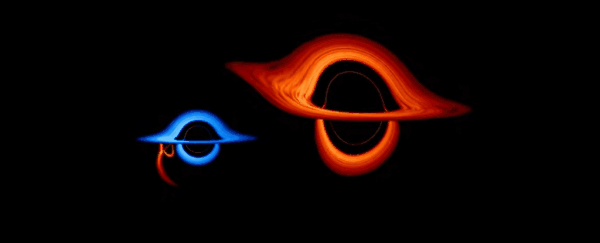Although it's extremely difficult to directly image the shadow of and the space around a black hole, that's not the only tool astronomers have in their kit.
Based on years of observations and analysis, there's a decades-long tradition of black hole visualizations, going all the way back to the work of French astronomer Jean-Pierre Luminet in the 1970s.
Fascinatingly, simulations came very close to what we saw when a huge international team of scientists finally captured a direct image of a supermassive black hole, the now-famous M87*. So we know that our predictions have traditionally been very accurate.
Because of the intense gravitational fields involved, stuff gets really whack. Light bends and its intensity changes, depending on which direction it's moving. So what happens when there's not one, but two black holes locked in mutual orbit, each with its own gravity, and each orbited by its own glowing accretion disk of dust and gas?
Well, it might look a little something like the latest, extremely trippy black hole visualization from NASA.
Building on his previous work of a simulated black hole and its accretion disk, astrophysicist Jeremy Schnittman of NASA's Goddard Space Flight Center chucked two black holes together to see what would happen.
"We're seeing two supermassive black holes, a larger one with 200 million solar masses and a smaller companion weighing half as much," he explained.
"These are the kinds of black hole binary systems where we think both members could maintain accretion disks lasting millions of years."
The simulation starts as though you are looking from the top down as the two supermassive black holes orbit each other. There's the black hole shadow in the middle of each, surrounded by a wide accretion disc.
The thin ring between the inner edge of the accretion disc and the black hole's shadow is called the photon ring, where the gravity is so strong that photons are trapped in a stable orbit around the black hole. If these photons were to veer any closer to the black hole, they would fall beyond the event horizon, where we can't see them.
As the simulation continues, the viewer's perspective moves down to the orbital plane of the two black holes.
At first, the simulation looks a lot like other simulations you may have seen, with the light of the disk bent at the back to form a halo, and the light in front of the black hole shadow brighter as it moves towards the viewer, and dimmer as it moves away. This is known as relativistic beaming and it's caused by the Doppler effect, which is the way waves (in this case, light waves) apparently change depending on their direction of travel.
Then it gets real weird, real quick.
Schnittman has used two different colors to represent the two black holes because it makes them easier to differentiate as the gravitational fields bend and warp, causing the light to travel complex curving paths, calculated using a powerful supercomputer. The light of each black hole becomes even more distorted as it is influenced by the gravity of its binary companion.
Then the view moves top-down, with a zoomed in view - where, travelling around the photon ring of one black hole is the side-on view of its companion. This is because the light is being bent 90 degrees, which means we get simultaneous top-down and distorted side-on views of each black hole.
"A striking aspect of this new visualization is the self-similar nature of the images produced by gravitational lensing," Schnittman said. "Zooming into each black hole reveals multiple, increasingly distorted images of its partner."
Gravitational lensing is, in fact, a useful tool for seeing into the deeper regions of space, since it magnifies and often duplicates the farther object. Galaxies and galaxy clusters can also be gravitational lenses, although the lensed objects do not appear quite as bendy and strange as the images produced by two active supermassive black holes.
Directly imaging a black hole is a lot of work, and binary supermassive black holes rare, so we're unlikely to see the real-life version of Schnittman's visualization any time soon - but simulations such as these can help us understand the physics of the extreme environments around supermassive black holes, so that we can better analyse the observations we can take.
Plus, they just look really awesome.
